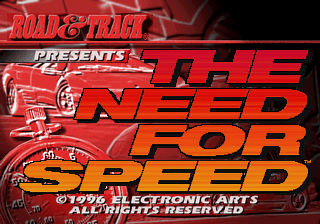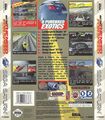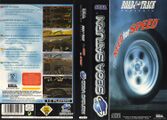Difference between revisions of "Road & Track Presents The Need for Speed"
From Sega Retro
| Line 1: | Line 1: | ||
| − | |||
{{Bob | {{Bob | ||
| bobscreen=NeedforSpeed title.png | | bobscreen=NeedforSpeed title.png | ||
| Line 5: | Line 4: | ||
| developer=[[Pioneer Productions]], [[Electronic Arts Canada]] | | developer=[[Pioneer Productions]], [[Electronic Arts Canada]] | ||
| system=[[Sega Saturn]] | | system=[[Sega Saturn]] | ||
| − | |||
| sounddriver= | | sounddriver= | ||
| peripherals= | | peripherals= | ||
| Line 26: | Line 24: | ||
| usk=0 | | usk=0 | ||
}} | }} | ||
| − | '''''{{PAGENAME}}''''', is a racing game developed by [[Pioneer Productions]] and published by [[Electronic Arts]] for a number of consoles including the [[Sega Saturn]]. | + | {{stub}}'''''{{PAGENAME}}''''', is a racing game developed by [[Pioneer Productions]] and published by [[Electronic Arts]] for a number of consoles including the [[Sega Saturn]]. |
In Japan, this game was significantly altered and released as ''[[Nissan Presents Over Drivin' GT-R]]''. | In Japan, this game was significantly altered and released as ''[[Nissan Presents Over Drivin' GT-R]]''. | ||
| Line 79: | Line 77: | ||
}} | }} | ||
|} | |} | ||
| + | |||
| + | ==History== | ||
| + | ===Development=== | ||
| + | ''The Need for Speed'' was developed in part by [[Electronic Arts Canada]], previously known as [[Distinctive Software]]. As a racing game attempting to simulate the feel of driving, it can therefore be seen as a spiritual successor to ''[[The Duel: Test Drive II]]'' (1990's ''Test Drive III: The Passion'' being developed by a different team for [[Accolade]]). | ||
| + | |||
| + | ==Versions== | ||
| + | The Saturn version of ''The Need for Speed'' derives from the DOS version, which in turn was an enhanced port of the 3DO original. While outputting at a smaller resolution, the Saturn shares many of the new textures introduced in the PC version and retains most of the new gameplay options (and adds a two-player split-screen option too). It also runs much faster than its 3DO counterpart, partly due to the console's improved performance (being able to output a stable 30FPS versus the 3DO's wavering 15FPS), but also due to design changes in the PC game to make ''The Need for Speed'' feel faster. | ||
| + | |||
| + | Whereas the horizon rotates slightly when going around corners in the 3DO version of the game, on the Saturn it remains fixed at all times. Unlike all other versions, gages in the cockpit view do not function at all on the Saturn, with these details being relegated to a much larger HUD. The Saturn version also allows users to select the time of day which is not seen in older versions. | ||
| + | |||
| + | While the PC version is generally considered to be the definitive version of the game, only high-end machines could utilise the game's top graphical settings in 1995. The PC version is also restricted to 8-bit colour, as opposed to the 16-bit or 32-bit colour depths found in the console ports. | ||
| + | |||
| + | The [[PlayStation]] adaption improves on what is found on the Saturn, re-introducing some of the minor details lost in the Saturn conversion while adding new lighting effects. Cruicially the PlayStation port is the only version to include in-game music, however its uncapped framerate means the game appears more "juddery" than its Saturn counterpart, as frame rates average between 30-35 FPS. Console additions would be re-introduced to the PC in the form of ''Road & Track Presents The Need For Speed SE'' in 1996. | ||
==Magazine articles== | ==Magazine articles== | ||
| Line 98: | Line 109: | ||
}} | }} | ||
}} | }} | ||
| − | |||
| − | |||
| − | |||
| − | |||
| − | |||
| − | |||
| − | |||
| − | |||
| − | |||
| − | |||
| − | |||
| − | |||
| − | |||
==Physical scans== | ==Physical scans== | ||
| Line 154: | Line 152: | ||
| front= | | front= | ||
| disc= | | disc= | ||
| + | }} | ||
| + | |||
| + | ==Technical information== | ||
| + | ===ROM dump status=== | ||
| + | {{romtable| | ||
| + | {{rom|SAT|sha1= |md5= |crc32= |size=663,031,152|date= |source=CD-ROM (EU)|comments=T-5009H-50 V1.000|quality=good|prototype=}} | ||
| + | {{rom|SAT|sha1= |md5= |crc32= |size=663,031,152|date= |source=CD-ROM (US)|comments=T-5009H V1.000|quality=|prototype=}} | ||
}} | }} | ||
==References== | ==References== | ||
<references/> | <references/> | ||
Revision as of 05:35, 5 May 2018
| Road & Track Presents The Need for Speed | ||||||||||||||||||||
|---|---|---|---|---|---|---|---|---|---|---|---|---|---|---|---|---|---|---|---|---|
| System(s): Sega Saturn | ||||||||||||||||||||
| Publisher: Electronic Arts | ||||||||||||||||||||
| Developer: Pioneer Productions, Electronic Arts Canada | ||||||||||||||||||||
| Genre: Racing | ||||||||||||||||||||
| Number of players: 1-2 | ||||||||||||||||||||
| ||||||||||||||||||||
This short article is in need of work. You can help Sega Retro by adding to it.
Road & Track Presents The Need for Speed, is a racing game developed by Pioneer Productions and published by Electronic Arts for a number of consoles including the Sega Saturn.
In Japan, this game was significantly altered and released as Nissan Presents Over Drivin' GT-R.
Contents
Gameplay
Cars
| Ferrari 512TR | |
|---|---|
| The Ferrari 512TR derives from the popular Ferrari Testarossa model (the star of Sega's arcade classic, OutRun). Only 512 vehicles were ever produced. | |
| Toyota Supra Turbo | |
| The Toyota Supra Turbo | |
| Acura NSX | |
| The Acura NSX is an Acura-badged version of the Honda NSX, renamed for North American consumers. | |
| Mazda RX-7 | |
| The Mazda RX-7 | |
| Porsche 911 Carrera | |
| The Porsche 911 Carrera | |
| Dodge Viper RT/10 | |
| The Dodge Viper RT/10 | |
| Corvette ZR-1 | |
| The Corvette ZR-1 | |
| Lamborghini Diablo VT | |
| The Lamborghini Diablo VT | |
| Warrior PTO E/2 | |
| The Warrior is a fictional secret car powered by jet fuel. |
History
Development
The Need for Speed was developed in part by Electronic Arts Canada, previously known as Distinctive Software. As a racing game attempting to simulate the feel of driving, it can therefore be seen as a spiritual successor to The Duel: Test Drive II (1990's Test Drive III: The Passion being developed by a different team for Accolade).
Versions
The Saturn version of The Need for Speed derives from the DOS version, which in turn was an enhanced port of the 3DO original. While outputting at a smaller resolution, the Saturn shares many of the new textures introduced in the PC version and retains most of the new gameplay options (and adds a two-player split-screen option too). It also runs much faster than its 3DO counterpart, partly due to the console's improved performance (being able to output a stable 30FPS versus the 3DO's wavering 15FPS), but also due to design changes in the PC game to make The Need for Speed feel faster.
Whereas the horizon rotates slightly when going around corners in the 3DO version of the game, on the Saturn it remains fixed at all times. Unlike all other versions, gages in the cockpit view do not function at all on the Saturn, with these details being relegated to a much larger HUD. The Saturn version also allows users to select the time of day which is not seen in older versions.
While the PC version is generally considered to be the definitive version of the game, only high-end machines could utilise the game's top graphical settings in 1995. The PC version is also restricted to 8-bit colour, as opposed to the 16-bit or 32-bit colour depths found in the console ports.
The PlayStation adaption improves on what is found on the Saturn, re-introducing some of the minor details lost in the Saturn conversion while adding new lighting effects. Cruicially the PlayStation port is the only version to include in-game music, however its uncapped framerate means the game appears more "juddery" than its Saturn counterpart, as frame rates average between 30-35 FPS. Console additions would be re-introduced to the PC in the form of Road & Track Presents The Need For Speed SE in 1996.
Magazine articles
- Main article: Road & Track Presents The Need for Speed/Magazine articles.
Promotional material
also published in:
- Electronic Gaming Monthly (US) #85: "August 1996" (1996-xx-xx)[5]
also published in:
- Computer & Video Games (UK) #177: "August 1996" (1996-07-11)[6]
also published in:
- CD Consoles (FR) #19: "Juillet/Août 1996" (1996-xx-xx)[7]
Physical scans
| Sega Retro Average | |||||||||||||||||||||||||||||||||||||||||||||||||||||||||||||||||||||||||||||||||||||||||||||||||||||||||||||||||||||||
|---|---|---|---|---|---|---|---|---|---|---|---|---|---|---|---|---|---|---|---|---|---|---|---|---|---|---|---|---|---|---|---|---|---|---|---|---|---|---|---|---|---|---|---|---|---|---|---|---|---|---|---|---|---|---|---|---|---|---|---|---|---|---|---|---|---|---|---|---|---|---|---|---|---|---|---|---|---|---|---|---|---|---|---|---|---|---|---|---|---|---|---|---|---|---|---|---|---|---|---|---|---|---|---|---|---|---|---|---|---|---|---|---|---|---|---|---|---|---|---|
|
| 82 | |
|---|---|
| Based on 23 reviews | |
| Saturn, BR |
|---|
|
Technical information
ROM dump status
| System | Hash | Size | Build Date | Source | Comments | |||||||||
|---|---|---|---|---|---|---|---|---|---|---|---|---|---|---|
| ✔ |
|
663,031,152 | CD-ROM (EU) | T-5009H-50 V1.000 | ||||||||||
| ? |
|
663,031,152 | CD-ROM (US) | T-5009H V1.000 |
References
- ↑ File:CVG UK 177.pdf, page 52
- ↑ 2.0 2.1 2.2 File:CVG UK 177.pdf, page 79 Cite error: Invalid
<ref>tag; name ":File:CVG UK 177.pdf_p79" defined multiple times with different content - ↑ 3.0 3.1 3.2 File:GamePro US 096.pdf, page 74 Cite error: Invalid
<ref>tag; name ":File:GamePro US 096.pdf_p74" defined multiple times with different content - ↑ 4.0 4.1 http://www.tectoy.com.br/releases/index.htm (Wayback Machine: 1998-06-25 19:48)
- ↑ Electronic Gaming Monthly, "August 1996" (US; 1996-xx-xx), page 66
- ↑ Computer & Video Games, "August 1996" (UK; 1996-07-11), page 62
- ↑ CD Consoles, "Juillet/Août 1996" (FR; 1996-xx-xx), page 6
- ↑ File:CDConsoles FR 19.pdf, page 118
- ↑ 9.0 9.1 File:ConsolesNews FR 02.pdf, page 90 Cite error: Invalid
<ref>tag; name ":File:ConsolesNews FR 02.pdf_p90" defined multiple times with different content - ↑ 10.0 10.1 File:MeanMachinesSega46UK.pdf, page 66 Cite error: Invalid
<ref>tag; name ":File:MeanMachinesSega46UK.pdf_p66" defined multiple times with different content - ↑ 11.0 11.1 File:SSM UK 09.pdf, page 64 Cite error: Invalid
<ref>tag; name ":File:SSM UK 09.pdf_p64" defined multiple times with different content - ↑ 576 KByte, "Július-Augusztus 1996" (HU; 1996-xx-xx), page 14
- ↑ CD Consoles, "Juillet/Août 1996" (FR; 1996-xx-xx), page 128
- ↑ Consoles +, "Juillet/Août 1996" (FR; 1996-0x-xx), page 158
- ↑ Digitiser (UK) (1996-07-18)
- ↑ Fun Generation, "09/96" (DE; 1996-08-14), page 76
- ↑ Joypad, "Juillet/Août 1996" (FR; 1996-0x-xx), page 87
- ↑ Kiber Zona, "1/1998" (LT; 1998-xx-xx), page 39
- ↑ Level, "4/97" (TR; 1997-xx-xx), page 1
- ↑ MAN!AC, "09/96" (DE; 1996-08-14), page 71
- ↑ Mega Force, "Été 1996" (FR; 1996-0x-xx), page 64
- ↑ Mega Fun, "08/96" (DE; 1996-07-17), page 80
- ↑ neXt Level, "September 1996" (DE; 1996-08-14), page 73
- ↑ Player One, "Juillet/Août 1996" (FR; 1996-0x-xx), page 127
- ↑ Sega News, "Listopad 1996" (CZ; 1996-1x-xx), page 21
- ↑ Sega Power, "Collectors' Issue 1996" (UK; 1996-07-xx), page 48
- ↑ Total Saturn, "Volume One Issue Four" (UK; 1996-12-29), page 58
- ↑ Ultra Player, "Juillet/Août 1996" (FR; 1996-07-02), page 84
- ↑ Video Games, "8/96" (DE; 1996-07-31), page 115
- Pages with reference errors
- 1-2 player games
- US Saturn games
- EU Saturn games
- BR Saturn games
- Saturn games
- 1996 Saturn games
- All 1996 games
- Saturn racing games
- Old content rating field
- All games
- Stubs
- GalleryPrintAd file defined
- Old-style rating (cdconsoles)
- Use magref
- Old-style rating (consolesnews)
- Old-style rating (consolesplus)
- Rating without PDF source
- Old-style rating (cvg)
- Old-style rating (digitiser)
- Rating without source
- Old-style rating (fungeneration)
- Old-style rating (joypad)
- Old-style rating (mms)
- Old-style rating (playerone)
- Old-style rating (segapower)
- Old-style rating (ssm)
- Old-style rating (videogames)
- Update ratings template
- 11 old ratings
- Missing ROM hashes
- Old technical information





